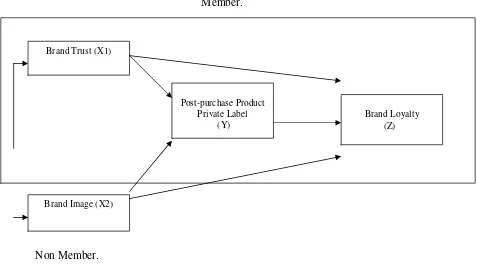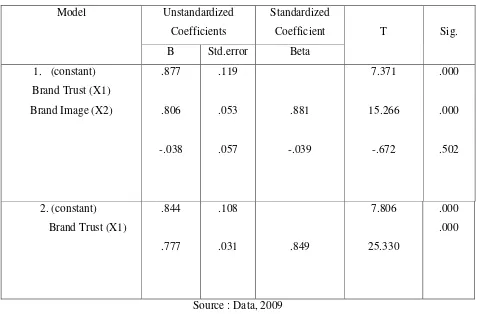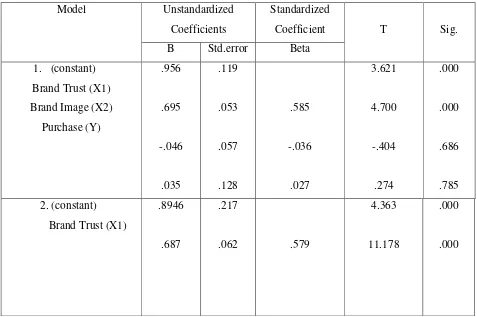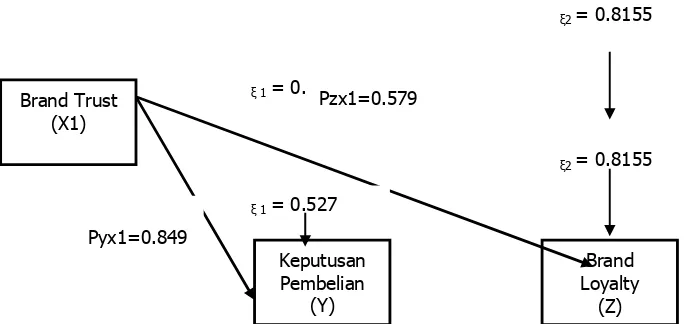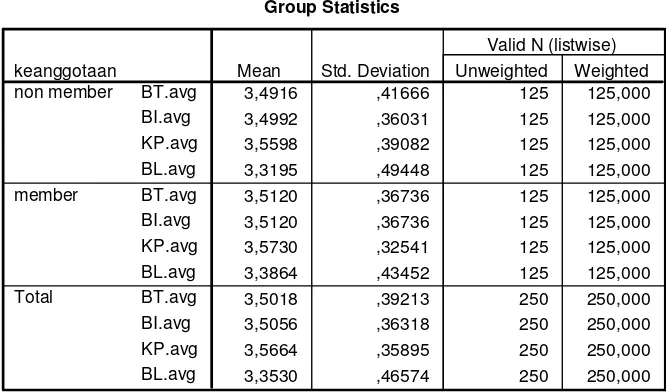Management Department Faculty of Business & Economics
Universitas Surabaya
ANALYSIS OF INFLUENCE BRAND TRUST AND BRAND
IMAGE TOWARDS PURCHASE DECISION THE PRIVATE
LABEL PRODUCT AND THEIR IMPACT ON BRAND
LOYALTY
Retno Dewanti
email : [email protected]
Ishak Ismail
email : [email protected]
Muhammad Jalu Tasrihanto
Aditya Prabowo
ABSTRACT
In the late 1950’s a situation had been changed which is the chain of distribution. Despite of the retailer has strengthen it positions to become more powerful than ever before. Brand of the distribution channel has tried to struggle gaining the market. Whole income from the asset of the private label Hypermart has gaining 4 % (percent) of income, this number will show a continuous growth as long as the retailer have showed the market trusts. the linkage from this condition will assume that the customer trusts will shown the positive image of its brand retail and there will be such a great opportunity to gain a private label brand and of course, the increase of the customer loyalty.
The methodology research is the descriptif asosiatif with the test of the assumption of PATH Analysis and Discriminant analysis. A sample design by using the probability sampling of cluster sampling has grouping the customer to member and non-member groups, instead of all the 250 customers.
the factor purchasing decision of a private label product could not become moderator variable for the brand and its variations.
Keywords: Brand trust, Brand image, Purchase decision, Brand loyalty
INTRODUCTION
In the 1950’s, market structure in distribution channel had been changed, the power itself has moved from fabric onto teh retailer ( seller). But the ruling was not wholesalers, but retailers. distributor brands is still very little suitable for famous brand manufacturers before the 1980s, after which the distributor brand really become a cheaper alternative than the manufacturer brand. Brand distributors continue to try to win the market, even these days the market share averaged 29% from sales of goods of daily needs in America, 37% in the UK, 19% in France, and 18% in the Netherlands. The success of this brand distributors to retailers to influence consumers at the place of purchase with a variety of ways. Brand distributors experiencing rapid growth phase both in the 20th century, when retailers began to apply the marketing techniques for new ways to ensure brand product distributor exactly 'real. "The brand packaging distributors not only become more modern, but raised the price of some products to intentionally influence consumer perceptions of quality. Since the 1990s more and more threatening distributors brand famous brand manufacturers. In Indonesia, together with a wider presence of giant retailers such as Makro, Hypermart, Giant, Carefour, Hero, etc.. the more popular is the private label products. In addition, promotion and marketing is now being handled and better packaging. "Hypermart" owned retailer PT Matahari Putra Prima Tbk. Indonesia is also offering private label products that reach the 4% turnover from the sale of Hypermart. This is evidence that brand trust created among the people Hypermart. PROBLEM STATEMENTS
Management Department Faculty of Business & Economics
Universitas Surabaya
members. This is not only useful for measuring the decision to purchase private label products as a mediating variable bridge brand trust and brand image in the creation of brand loyalty is to explore the differences and non-members to members in the decision to purchase private label products Hypermart.
LITERATURE REVIEW
Private label is a brand or product specific brand provided by the company to offer to consumers in addition to other company brands. (Kotler and Keller, 2006) A trend of marketing decisions and the main concern for retailers private label. Durianto (2002: p2) brand becomes very important because it allows the brand purchase decision-making process. A product with a positive brand image and consumer trust to meet the needs and desires, it will grow naturally consumer purchasing decisions for goods and services offered. Conversely, if a negative brand image in the eyes of consumers, consumer purchase decision this product would be low. Mustopa and Ramadhani (2008: p32). (Aaker, 1991: p39; Rangkuti, 2004: p61) Brand Loyalty is a measure of attachment to the customer a brand. (Keegan, et al: 1995: p6; Tjiptono 2005: p387) Brand loyalty is the customer's tendency to consistenly have a positive attitude toward a particular brand and to buy it again and again from time to time. Mowen (2002, p109) that loyalty can be based on actual purchase behavior associated with the proportion of purchases. Durianto (2001, p132) Measuring brand loyalty, among others: Behavior sizes, Switching costs, Measuring satisfaction, like Measure brand, commitment.
CONCEPTUAL MODEL AND HYPOTHESIS DEVELOPMENT
Management Department Faculty of Business & Economics
Universitas Surabaya
Member.
Non Member.
Non member
Figure 1: Path model on Brand trust, Brand Image, towards Post Purchase Product private label and their impact on Brand Loyalty.
Based on the path model, two structural equalities have been developed:
Y = YX11 + YX12 + YX13 + ε1 (as sub-structure 1)
Z = ZX11 + ZX12 + ZX13 + ZY + ε2 (as sub-structure 2)
In addition, three hypotheses have been formulated:
Hypothesis 1: Brand Trust, Brand Image have significant effects towards Purchase Product Private Lable.
Hypothesis 2: Brand Trust, Brand Image, Purchase Product Private Lable have significant effects towards Brand Loyalty
Brand Trust (X1)
Brand Image (X2)
Post-purchase Product Private Label
(Y)
Discriminant analysis used explain hypothesis 3
Hypothesis 3: Any Discriminand factor on consumer behaviour of member and non member Hypermart
METHODOLOGY Sampling:
This study focuses only on the Hypermart in West Jakarta. In view of the large population of consumers patronising the Hypermart, Cochran’s (1963) formula was used to yield a representative sample for proportions. This resulted in a minimum of 96 consumers in which data must be collected from. Self-reporting questionnaires were randomly disseminated to 250 consumers divided on member and non member Hypermart.
2
e= error sampling (estimation accepted)
Management Department
the Cronbach alpha is to 1.0, the higher the internal consistency. The reliability test showed alpha coefficients of 0.60 and higher for the questions, which shows evidence of sufficiency in terms of internal consistency of the instrument (Hair, Anderson, Tatham, & Black, 1998).
Table 3: Reliability Analysis
Variables Cronbach’s Alpha
Brand Trust (X1) 0,895
Brand Image (X2) 0,951
Purchase Product Private Lable (Y) 0,903
Brand Loyalty (Z) 0,954
Source: Analysis of data collected.
RESULTS
Anova conducted to determine the overall impact of Brand Trust, Brand Image, for the Purchase Decision. The results of calculations using SPSS.
Table 4: Simultanous Influences of brand trust and Brand Image towards Purchase Product Private Lable
probability value (Sig) of Table 4 obtained Sig value for 0000, because the value of Sig <0.05 then the decision is Ho refused and Ha accepted. This means that there is significant influence between the Brand Trust, Brand Image, for the Purchase Decision. Coefficient analysis performed to determine the individual contribution of Brand Trust, Brand Image, for the Purchase Decision. The results of calculations using the SPSS program shown in the following table:
ANOVAb
23,154 2 11,577 320,314 ,000a
8,927 247 ,036
Squares df Mean Square F Sig.
Predictors: (Constant), BI.avg, BT.avg a.
Tabel 5: Coefficients Model 1 dan model 2 – Sub.structure 1
Source : Data, 2009
Based on structure analysis of sub-lines 1 (X1, X2, Y) are shown in Table 1 Coefficient of 4:11 models of each value obtained from: a.) yx1 = Beta = 0881 [t = 15,266 and the probability (sig) = 0000 ] b. ) yx2 = beta = -0.39 [t = -0672, and the probability (sig) = 0502] The analysis showed that there was no significant path coefficients, ie the brand image variables (x2), then the model 1 method should be improved by trimming , who published a brand image variable (x2) is considered as a result of the path coefficient was not significant from the analysis. Then again or tested else where exogenous brand image (x2) does not include Figure 1: Framework of empirical causal relationship between X1, X2, Y can be done through structural equation as follows:
Management Department
1 = 0.527
Struktur: Y = yx1 X1 + y 1 = 0.881X1 + 0.527 1 R²y.x1 = 0.721
y = 1-R² y.x1 = 1-0.721 = 0.279 = 0.528
The analysis is then performed using Anova table for determining the overall impact of Brand Trust, Brand Image, and Brand Purchase Decisions loyalty. The results of calculations using the SPSS program shown in the following table:
Tabel 6: Simultanous Influences of brand trust and Brand Image, Purchase Product Private Lable towards Brand Loyalty
Source : Data, 2009
Value sig 0000, because the value of Sig <0.05 then the decision is Ho refused and Ha accepted. This means that there is significant influence between the Brand Trust, Brand Image, and Purchase Decisions brand loyalty.
ANOVAb
18,131 3 6,044 41,438 ,000a
35,879 246 ,146
54,011 249
Regression Residual Total Model 1
Sum of
Squares df Mean Square F Sig.
Predictors: (Constant), KP.avg, BI.avg, BT.avg a.
Tabel 7: Coefficients Model 1 dan model 2 – Sub.struktur 2
Sumber : Data, 2009
Based on the results of the coefficient on the structure lines 1 and 2 sub-structure, can be described as a whole that describes empirical causal relationship between the variables X1, X2, Y, Z in Fig. 2 as follows:
Management Department Faculty of Business & Economics
Universitas Surabaya
Fig 2: Causal Empiris Variabel X1 Toward Y and Z
The results of the coefficient on the structure lines 1 and 2 sub-structure in the sub-structure of the equation is:
Y= Pyx1 + Py 1 dan R2yx1
= 0.849 + 0.527 dan R2yx1= 0.721 Z= PZx1 + PZ 2dan R2zx1
= 0.579 + 0.8155 dan R2zx1 = 0.335
With the formation of fine structure of the pattern of causation between X1 and y to z then clear that the variable x1 Brand Trust as a determinant variable in the decision to purchase and also on brand loyalty. Means that programs that successfully carried out by Hypermart is to convince customers that influence purchasing decisions and brand loyalty is also influenced. Purchasing decisions private label products do not become a mediator between brand trust and brand loyalty brand image brand loyalty.
Analisis Discriminant Consumer behaviour of Member and Non Member Hypermart
!" ##
! #"$
% &
' (
)
* #$
!" ##
Hipotesis :
Ho : U1 = U2: Vector the average value of the membership status of members and non-members is the same.
Ha : U1 U2 : Vector the average value of the membership status of members and non-members of different / not equal
Condition foe Trial Hypotesis will be :
+ Ho received by 0:05 If the probability value of less than or equal to the value or the probability sig [0:05 Sig], Ho Ha received and rejected, it means not significant.
Ha accepted if the probability value of 0:05 greater than or equal to the value or the probability of sig [Sig 0:05], so that Ho refused and Ha is received, which means significant.
Tabel 8: Group Member and Non member Hypermart
Management Department Tabel 9: Tests of Equality of Group Means
Source : Data, 2009
Seen from table 9 shows that the differences in membership status test members and non members to achieve significant results as follows: • Based on the above discriminant test can be stated that the behavior of customers and non-members do not differ in perceptions of brand trust, brand image, the decision purchase of private label products and brand loyalty. This means that require further evaluation of the success of the card member benefits offered by Hypermart, because in reality the choice becomes a member or non-members not because of brand trust, brand image, brand loyalty and purchasing decisions. CONCLUSION
Brand Trust and Brand Image shows a significant impact on the Trust's decision to Pembelian.Brand purchases obtained by the conclusion that the Brand Trust showed a significant influence in the 0849 ² = 0.7208 or 72.08% of the purchase decision. This shows that the Trust can make a brand purchase decision directly because it has a significant influence. Thus, in deciding to purchase private label products so that consumers feel the need to have a sense of security and trust that will be purchased brand. Thus, brand trust relationships necessary to obtain optimal purchasing decisions. From the analysis and explanation of variables to four statements in the case of Brand Trust Members Hypermart respondents found the statement that the intention of the most prominent brands than any other statement. Therefore concluded that Hypermart meet the needs of customers in the store everyday needs. While the analysis and explanation of the four variables declaration Brand Trust in the case of non-Members of the respondents found the statement Hypermart reliability of the most prominent
Tests of Equality of Group Means
brands compared with that other statement . Therefore concluded that Hypermart always put the interests of consumers. Based on the above analysis Hypermart is expected to continue to maintain confidence in the brand Hypermart to convince consumers continue to buy private label products. Analysis of the influence of Brand Trust, Brand Image, and Brand Loyalty purchasing decision indicates that there is significant influence of Brand Trust, Brand Image, and Purchase Decisions brand loyalty.
Analysis of Brand Loyalty Brand Trust to obtain the result that there is a significant influence in the 0579 ² = 0.3352 or 33.52% on Brand Loyalty. This indicates that the variable Brand Trust can create brand loyalty directly. In line with the theory that the trust mark providing a positive influence on brand loyalty (Chauduri & Holbrook, 2001; Rizal Edy Halim, 2006; Lau and Lee, 1999; Gede Riana, 2008). With this conclusion Hypermart is expected to continue to maintain confidence in the brand to continue to have brand loyalty. Next to see if there is a difference between consumer behavior and non-member member Hypermart daan mogot discriminant analysis performed. real choice to become a member or non-members not because of brand trust, brand image, brand loyalty and purchasing decisions.
Management Department Faculty of Business & Economics
Universitas Surabaya REFERENCES
Aaker, David. A. 1996. Building Strong Brands. New York: The Free Press. Consumer Behavior.
www-rohan.sdsu.edu/~renglish/report/printing_notes.htm. Assael, Henry. 1998. Marketing. Dryden Press.
Baker, J. (1986). The Role of the Environment in Marketing Services: The Consumer Perspective. In John A. Cecil et al. (Eds.). The Service Challenge: Integrating for Competitive Advantage. Chicago: American Marketing Association, 79-84.
Ballester, Elena Delgado and Jose Luis Munuera-Aleman. 2003. European Journal
of Marketing.
http://www.emeraldinsight.com/Insight/viewContentItem.do;jsessionid=2C6CEB
897409449B3A432996812898D7?contentType=Article&contentId=853761
Beatty, Sharon E., James EC, Kristy ER, and Jungki Lee. 1996. Customer-Sales Associate Retail Relationhip. Journal of Retailing, Vol. 72, No. 3.
Berman B., and Evans J.R. 2001. Retail Management A Strategic Approach. Eight Edition, Prentice Hall., Inc., New Jersey, USA.
Cochran, W. G. (1963). Sampling Techniques, 2nd Ed., New York: John Wiley and Sons, Inc.
Dharmmesta, B.S. 1999. Loyalitas Pelanggan: Sebuah Kajian Konseptual Sebagai Panduan Bagi Peneliti. Jurnal Ekonomi dan Bisnis Indonesia, Vol. 14, No. 3.
Durianto, Darmadi; sugiarto; Tony Sitinjak. 2004. Strategi menaklukkan pasar : melalui riset ekuitas dan perilaku merek. Penerbit Gramedia Pustaka Utama. Jakarta
Elsevier Food International. (2006). Indonesia’s Rapid Retail Development. Available:
http://www.foodinternational.net/articles/country-profile/164/indonesias-rapid-retail-development.html [2009, March 4].
Euromonitor (2009). Retailing in Indonesia. Available: http://www.euromonitor.com/Retailing_in_Indonesia?print=true [2009, April 3].
Gerson, Richard F, PhD. 2001. Mengukur Kepuasan Pelanggan, Panduan Menciptakan Pelayanan Bermutu, Jakarta: Penerbit PPM
Gurviez, Patricia and Michaël Korchia. 2003. Proposal for a Multidimensional Brand Trust Scale
Hair, J.F., Anderson, R. E., Tatham, R.L., and Black, W. C. (1998). Multivariate Data Analysis, Fifth Edition, Prentice-Hall: Upper Saddle River
Hurriyati, R. 2005. Bauran pemasaran dan loyalitas konsumen. ALFABETA. Bandung.
Johnson, M.D., and Nilsson, L. (2003). The Importance of Reliability and Customisation form Goods to Services. Quality Management Journal, 10(1), 8-19.
Kartajaya, Hermawan. 2005. 4G Marketing: A 90-Year Journey in Creating Everlasting Brands. MarkPlus&Co, Jakarta.
Kartajaya, Hermawan. 2005. Marketing in Venus Playbook Volume II. MarkPlus&Co. Jakarta.
Kent, T. (2007). Creative Space : Design and The retail Environment. Availabe: www.emeraldsight.com/0959-0552.htm [2007, October 25].
Kotler Philip dan A.B. Sutanto, 2000, Manajemen Pemasaran di Indonesia (Analisis, Perencanaan, Implementasi, dan Pengendalian) buku satu, Jakarta: Salemba Empat.
Kotler, P. (2002). Manajemen Pemasaran : Milenium. Jilid-1. PT Prenhallindo, Jakarta.
Kotler, Phillip and Kevin L. Keller. 2006. Marketing Management. Prentice Hall. Kotler, Phillip and Gary Armstrong. 2006. Marketing. Prentice Hall.
Kotler, Philip, 1998, Manajemen Pemasaran : Analisis, Perencanaan,
Management Department Faculty of Business & Economics
Universitas Surabaya
Lau, Geok Then and Sook Han Lee, 1999, Customer’s Trust in a Brand and the Link to Loyalty, Journal of Market Focussed Management, 4.
Lau, H.C.W; W.B. Lee and Peter K.H. Lau. 2000. Development of an intelligent decision support system for benchmarking assessment of business partners. Benchmarking : An International Journal.
http://www.emeraldinsight.com/Insight/viewContentItem.do;jsessionid=CC
EE2D4BC694BC517F5A2272CDD6C853?contentType=Article&contentId
=843036
Lee,W.B and H.C.W. Lau. 1999. International Journal of Agile Management Systems.
http://www.emeraldinsight.com/Insight/viewContainer.do?containerType=J
OURNAL&containerId=11891
Lewis, and Spyrakopoulos. (2001). Service Failures and Recovery in Retail Banking: The Customer’s Perspective. International Journal of Bank Marketing, 19(1), 37-47.
Maulana, Agus, 1999. Perilaku Konsumen Di Masa Krisis, Implikasinya Terhadap Strategi Pemasaran. Usahawan No1 Th. XXVIII, edisi Januari. Newman. (2001). Interrogating SERVQUAL: A Critical Assessment of Service Quality Measurement in a High Street Retail Bank. International Journal of Bank
Marketing, 19(3), 126-139.
Parasuraman, A., Zeithaml, V., and Berry, L. (1988). SERVQUAL: A Multiple-item Scale for Measuring Consumer Perceptions of Service Quality. Journal of Retailing, 64(1), 12-40.
Peter, J.P and Jerry C. Olson, 1999, Consumer Behaviour : Perilaku Konsumen dan Strategi Pemasaran. Erlangga. Jakarta.
Peter, Paul. J. 1999. Preface To Marketing Management. Mcgraw-hill.
Rangkuti,, Freddy. 2002. Riset Pemasaran, Cetakan 5. PT. Gramedia Pustaka Utama. Jakarta.
Rotter, J.B. (1967). A New Scale for Measurement of Personal Trust. Journal of Personality, 35(4), 651-665.
Rotter, J.B. (1971). Generalised Expectations for Interpersonal Trust. American Psychologist, 26(5), 443-452.
Rotter, J.B. (1980). Interpersonal Trust, Trustworthiness, and Gullibility. American Psychologist, 35(1), 1-7.
Rousseau, D.M., Sitkin, S.B., Burt, R.S., and Camerer, C. (1998). Not So Different Afterall: A Cross-Discipline View of Trust, Academy of Management Review, 23(3), 393-404.
Santoso, Singgih dan Fandy Tjiptono. (2002). Riset Pemasaran : Konsep dan Aplikasi dengan SPSS. PT. Elex Media Komputindo. Jakarta
Schiffman, L., and Leslie Lazar Kanuk. (2002). Consumer Behaviour : Seventh Edition. Prentice Hall Int, Inc, New Jersey
Sekaran, U. (2003). Research Methods for Business: A Skill Building Approach, 4th Edition.New York: John Wiley & Sons, Inc.
Simamora, Bilson. 2004. Panduan Riset Perilaku Konsumen. PT. Gramedia Pustaka Utama. Jakarta.
Tjiptono, Fandy, dan Gregorius Chandra. 2005. Service, Quality & Satisfaction, Penerbit Andi, Yogyakarta.
Tingkat Kepercayaan Kosumen Bakal Naik@ Mesin Kasir (2009, March 24). http://indocashregister.com/2009/03/24/tingkat-kepercayaan-konsumen-bakal-naik-mesin-kasir/
Utama, Diosi Budi Utama. 2007. Membangun Merek, Membentuk Kepercayaan Konsumen dan Menciptakan Loyalitas Merek. Jurnal Telaah Manajemen. Utami, Whidya. 2006. Relationship Effort dan Kualitas Layanan Sebagai Strategi
Penguat Relationship Outcomes. Jurusan Manajemen Pemasaran, Fakultas Ekonomi – Universitas Kristen Petra.
Management Department Faculty of Business & Economics
